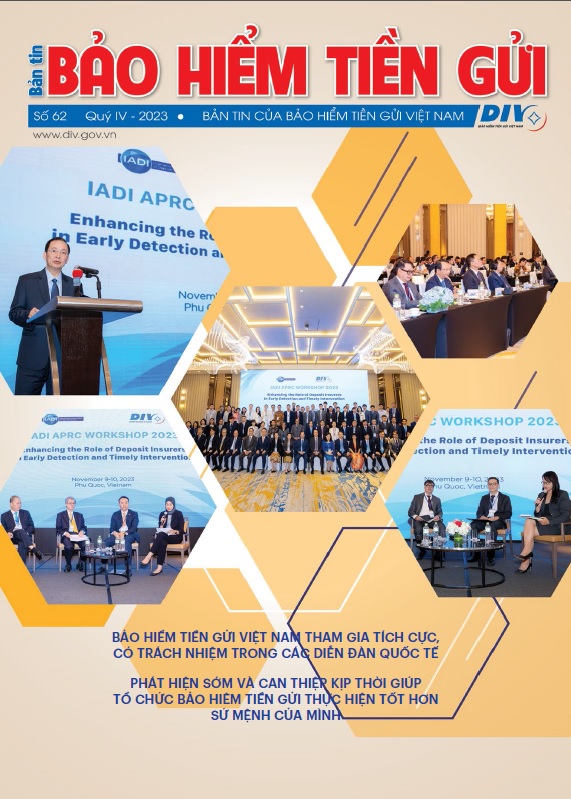Refresh the early intervention process
Early intervention is the SBV’s request for credit institutions and foreign bank branches to remedy the situation specified in Chapter VIII - Early Intervention of Credit Institutions - of the draft revised Law on Credit Institutions.
In the report summarizing the implementation of the Law on Credit Institutions in 2010 and the Law amending and supplementing a number of articles of the Law on Credit Institutions in 2017, the SBV said that the revised Law on Credit Institutions in 2017 provided for the application of early intervention to credit institutions and foreign bank branches in some cases that have not yet been put under special control (Article No.130a). Accordingly, from the date of receipt of documents on application of early intervention from the SBV, credit institutions and foreign bank branches must report to the SBV on the situation, causes, plans to remedy the situation and organize the implementation of the measures. The maximum remedial project is 01 year, which includes one or several measures such as: Narrowing of contents, scope of activities, restriction of large transactions; Increasing charter capital and allocated capital; Increasing holding of highly liquid assets; selling, transfering assets and implementing other solutions to meet safety requirements in banking activities; limiting dividend payment and profit distribution; cutting operating costs, management costs; limiting the payment of remuneration, salaries and bonuses to managers and executives; strengthening risk management; reorganizing the management apparatus, reducing personnel and take other measures as prescribed.
However, there is no regulation on necessary support measures in case of early intervention for credit institutions. Therefore, to implement the early intervention mechanism, according to the SBV, it is necessary to supplement measures to support credit institutions to overcome shortcomings and weaknesses that lead to the application of early intervention.
To overcome this, the draft revised Law on Credit Institutions develops an early intervention process that adds the authority of the SBV at the early intervention stage, and stipulates a number of measures currently being applied at the special control stage to the early intervention stage, allowing early and remote handling when the credit institution's weakness has not yet reached a serious level.
In the process of inspection and supervision of credit institutions, based on the results of supervision and inspection, depending on the level and problems encountered by each credit institution, the SBV will apply appropriate measures such as recommendations and reporting, enhanced surveillance, early intervention, and special control.
Thus, early intervention is only one of the measures applied to credit institutions with specific signs that are suitable to the status of each credit institution. Specifically:
During the supervision of credit institutions, based on the results of supervision, the SBV can give recommendations and warnings to credit institutions. Credit institutions are responsible for reporting, explaining, developing remedial plans and sending them to the SBV and organizing the implementation.
After implementing the remedial plan, the credit institution that continues to have potential risks, potentially violating the monetary and banking laws, or based on the rating results, the credit institution will be considered for application of enhanced supervision.
In the case of credit institutions showing symptoms such as failure to maintain solvency ratio, failure to maintain capital adequacy ratio, risk of insolvency, etc. the SBV will apply the provisions on early intervention and special control specified in the draft Law.
When a credit institution is put under early intervention, depending on the status of the credit institution, the credit institution will have to develop: a remedial plan, a support plan before special control, a plan for merger, consolidation, and dissolution. At the early intervention stage, the first priority measure to be applied is for the credit institution to develop its own plan to overcome weaknesses, in which, the credit institution, its owners and shareholders must strengthen their responsibilities, its obligations such as increasing charter capital, allocated capital; increasing holding of highly liquid assets; selling, transferring assets and implementing other solutions to meet safety requirements in banking activities; cutting operating costs, management costs; cutting remuneration, salary and bonus for managers and executives; limiting or not paying dividends, transferring shares, transferring assets; improving management and administration capacity, strengthening risk management; reorganization of the management and administration apparatus... These are resolution measures associated with the rights and responsibilities of shareholders, managers and executives of credit institutions.
In addition, credit institutions may also be considered for applying stronger restrictive measures such as limiting inefficient business activities, suspending or temporarily suspending one or a number of banking and other business activities, restricting the decision-making authority in business activities of managers and executives; suspending managers, executives who violate the law... Depending on the status of the credit institution as well as the results of the implementation of the plan, the credit institution will be subject to increasing restrictions, including putting into special control and applying forced transfer measures or bankruptcy if the credit institution's problems cannot be overcome, leading to the risk of causing system insecurity.
Supplement the participation of the deposit insurer
The Law on Credit Institutions 2017 currently does not have regulations on allowing the Deposit Insurance of Vietnam (DIV) and the Cooperative Bank to participate in the application of early intervention measures for weak PCFs. Along with that, the Law on Credit Institutions does not have specific provisions on sending seconded commune-level cadres to hold the positions of Chairman and Director of the specially controlled People's Credit Fund. At the same time, the fact that some units (such as the DIV, commercial banks with more than 50% of charter capital held by the State ...) appointing personnel so that the State Bank of Vietnam's branches in provinces and cities appoint them with the title of Chairman, Director of the specially controlled People's Credit Fund also faces legal difficulties. Not to mention, according to the provisions of Article No.22 of the Law on Deposit Insurance and Article No.155 of the Law on Credit Institutions, Clause 5, Article 146a of the Law on Credit Institutions as amended and supplemented, the DIV cannot make payments in case the People's Credit Funds do not have the bankruptcy plan being approved. This, according to the drafting agency of the revised Law on Credit Institutions, makes it difficult for the resolution process to stabilize depositors’ psychology.
Therefore, among supporting measures at the early intervention stage, on the basis of supporting measures in the special control stage, the draft Law supplements measures from supporting credit institutions, at the same time with the participation of the DIV and the Cooperative Bank. These are all resources mobilized from within the credit institution system, improving the responsibility of credit institutions for maintaining and ensuring system safety, and at the same time reducing pressure and costs for management agencies in the weak credit resolution process.
Specifically, for the participation in the early intervention process of the DIV, in order to timely protect the interests of depositors and ensure the safety of the credit institution system, the SBV has issued a document to apply early intervention including the status and reasons why credit institutions need the support of the DIV. Depending on the actual situation, nature and risk level of the situation requiring early intervention of a credit institution or foreign bank branch, the DIV may participate in one or more of the following early intervention measures: developing a plan for payout; providing special loans to support liquidity when credit institutions are at risk of insolvency and threatening the stability of the system; and supporting the implementation of the remedial plan, the pre-special control support plan, the compulsory transferring plan, etc.
It can be said that the participation of the deposit insurer in the early intervention process shows the role of the deposit insurer in ensuring the safety of the system as well in the restructuring of credit institutions. In order to make the most of the deposit insurer's resources, it is necessary to amend the Law on Deposit Insurance as soon as possible. There are opinions that it is necessary to amend the Law on Deposit Insurance at the same time as the Law on Credit Institutions. However, up to this point, the Law on Deposit Insurance has not been included in the list of Law projects to be amended and supplemented in the National Assembly's Law and Ordinance Development Program for 2023 and 2024.

























